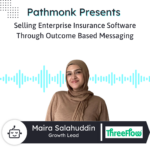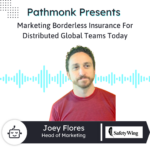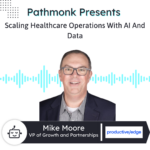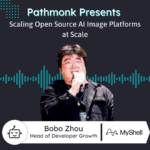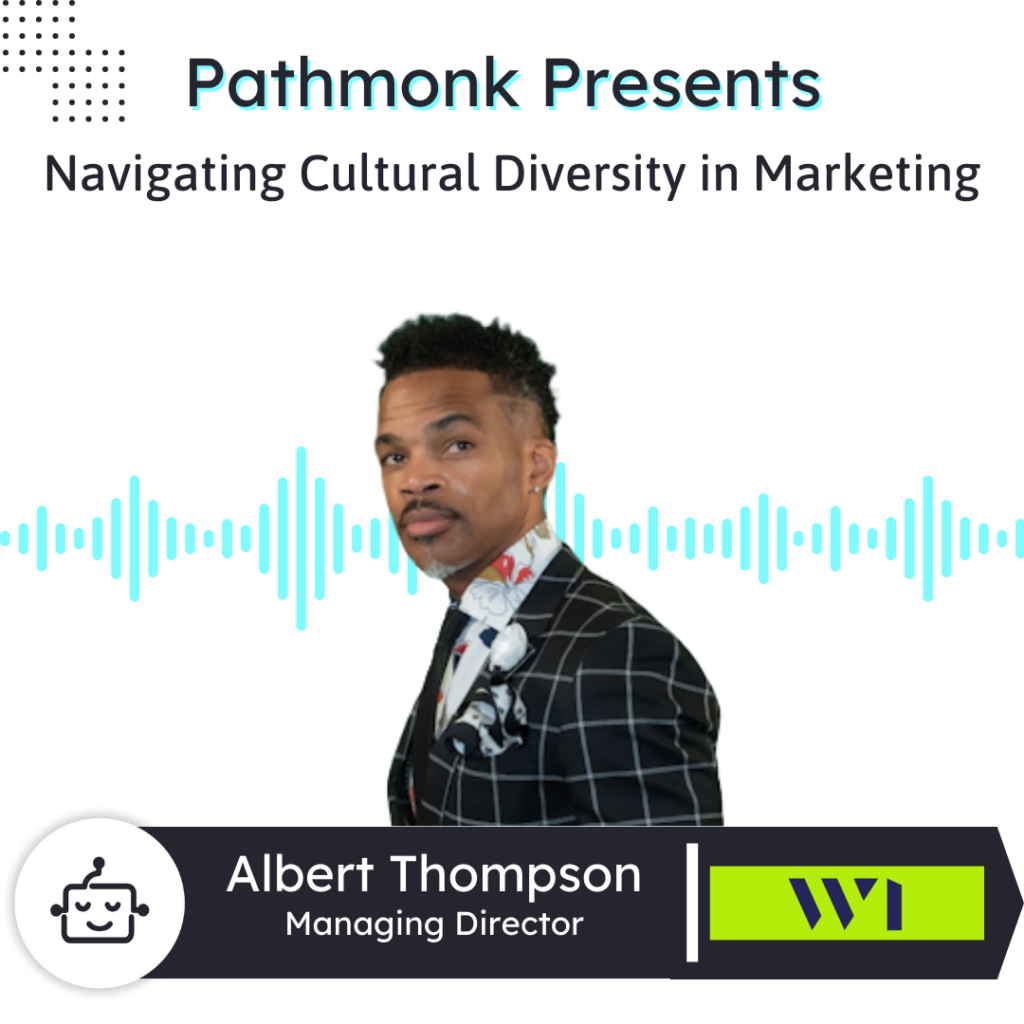
Introduction
Albert Thompson, Managing Director of Digital Innovation at Walton Isaacson, shares insights on the agency’s culture-first approach to marketing.
With a diverse team representing over 50 ethnic groups, Walton Isaacson specializes in helping brands connect authentically with diverse audiences. Thompson discusses the importance of understanding consumer voices and building industry relationships.
He emphasizes the value of thought leadership and networking in client acquisition, as well as the need to adapt to evolving digital marketing landscapes.
More Sales From Your Website With AI
Personalized interactions based on your users' behaviour to get +50% more conversions.
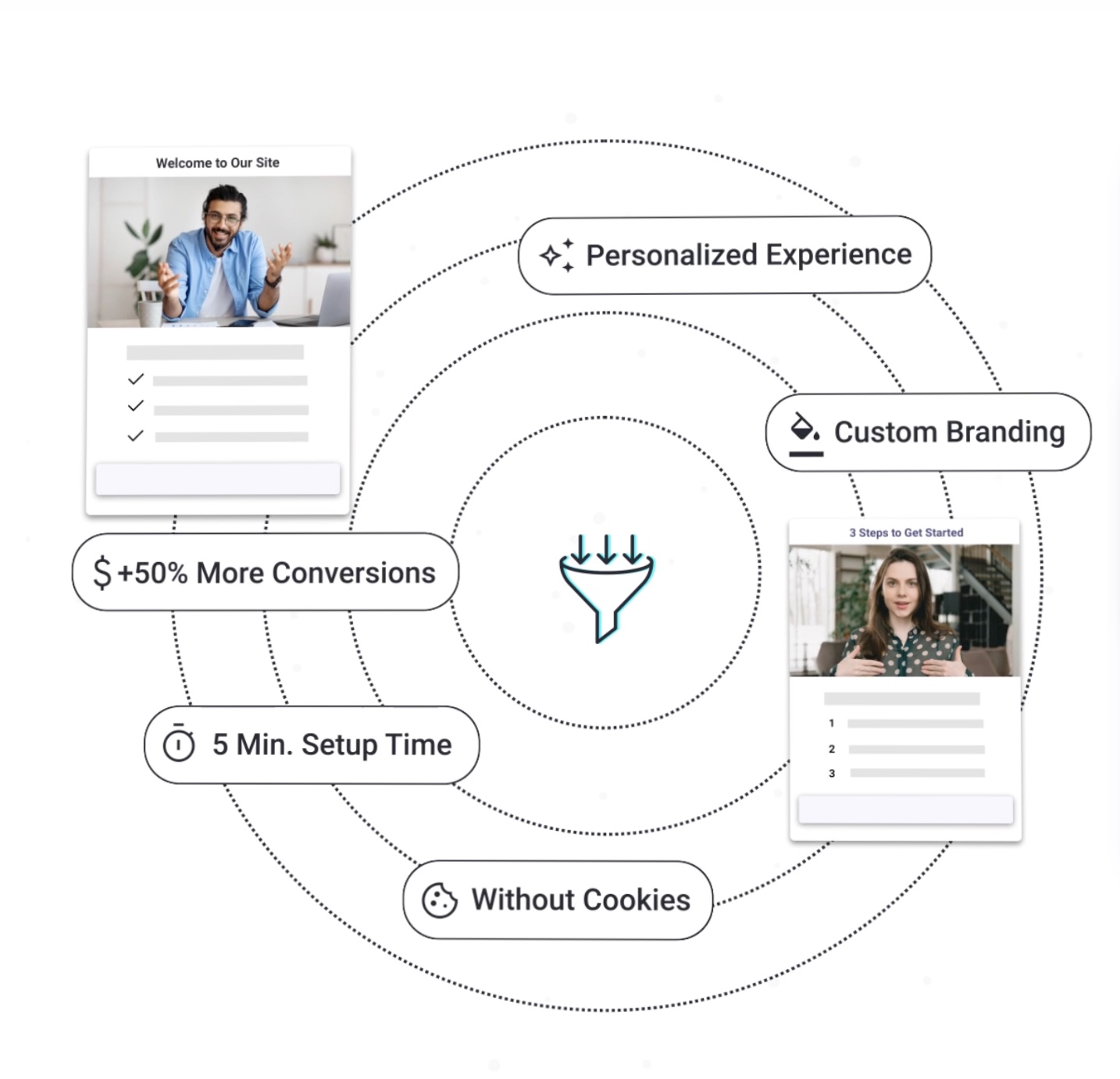
Ernesto Quezada: Pathmonk is the intelligent tool for website lead generation. With increasing online competition, over 98% of website visitors don’t convert. The ability to successfully show your value proposition and support visitors in their buying journey separates you from the competition online. Pathmonk qualifies and converts leads on your website by figuring out where they are in the buying journey and influencing them in key decision moments. With relevant micro-experiences like case studies, intro videos, and much more, stay relevant to your visitors and increase conversions by 50%. Add Pathmonk to your website in seconds. Let the AI do all the work and get access to 50% more qualified leads while you keep doing marketing and sales as usual. Check us on pathmonk.com. Welcome to today’s episode. Let’s talk about today’s guest. We have Albert from Walton Isaacson, managing director there with them. How you doing today, Albert?
Albert Thompson: Doing well. How you doing today, sir?
Ernesto: I’m doing great. Thank you so much for asking. And, well, I’m sure our listeners are tuning in, wondering what Walton Isaacson is all about. So, in your own words, can you tell us a little bit about them?
Albert: No, absolutely. First of all, appreciate the Mexico to DC connection. So it’s always good to connect with people, you know, in other hemispheres or other parts of the globe just to get that unique perspective. I mean, for us, we’re a culture-first agency. I think within the staff that’s somewhere in the low 100s, we probably have representation of 50 different ethnic groups. And, you know, when you start to look at Latinos, we got people that represent the subculture from, you know, Venezuelans to Colombians, to Dominicans to Puerto Ricans. You know, it’s the same thing when you start looking at people who identify as African American versus African. We have people that are part of the LGBTQ acronym. You know, we obviously got Caucasians to work within the company, but we’ve always been an agency that better, as suited to, that faces the world the way it faces them. There are a lot of brands that face diverse audiences, got diverse consumers. The leadership isn’t diverse at all. And then you wonder why people are struggling in the marketplace. But that’s always been sort of our ethos. It’s that you have to live in culture. Everything sort of lives in culture. So when I say we’re a culture-first agency, a lot of the solves we do is take brands who’ve either lost sight of it, haven’t properly pursued it, or don’t live in it, who now need to get immersed within the throes of it. So, that’s very much our stick. But like I said, great to be on the podcast and have this conversation with you.
Ernesto: Definitely appreciate that. And, so that way our listeners could get just a little bit of an understanding there of Walton Isaacson. Then what would you say that key problem that you guys like to solve for clients?
Albert: Yeah, I think I look, I think people just don’t understand the voice of the consultation. There are a lot of people sitting in boardrooms, sitting in meetings, developing audience profiles, and we have to level set them and say, but that’s not the buyer. That’s not what they would do. And the things that you’re doing don’t necessarily resonate. So we’re always trying to sort of tune this up and help them understand that, so they understand how to pull that forward. And that’s a big thing that we’re always pretty strong at understanding and breaking down the marketplace dynamics. I mean, look, you can look at a series of categories, healthcare, banking, and finance. And you can understand that they have a degree of tone deafness, their ability to understand culture and participate in play. So our thing has always been able to sort that off.
Ernesto: All right, awesome. Awesome. And so on that note, is there a certain vertical, is there a segment, is there an ideal ICP there, for Walton?
Albert: You know, I don’t think there really is. I mean, when you look at the challenges, I mean, look, the agency started really focused on creative, experiential, brand and entertainment. And I think the layer that’s always been, has been the entertainment factor, that the world doesn’t need another agency. It has to find a way of taking brands and putting them within culture in new, unique ways versus just the status quo of shouting at consumers within it. So when I start to look at it, I think it’s more of an ethos of how we showed up, less of on a specific vertical. I mean, look, we’ve done a ton of automotive stuff. We knew that the Lexus worked for over a decade and a half, nearly two decades probably, if you look at the very, very beginning, done a decent amount of banking and finance, a little bit of healthcare. We’ve done a lot of alcohol and beverage. We’ve done CPG brands, Unilever and Jim Beam. So the agency has really stretched its mark in a series of categories to sort of make its name. But we’re not like, we’re heavily verticalized around one particular consumer type or one particular vertical type.
Ernesto: Okay, awesome. Great, Albert. So, what would you say then, is a top client acquisition channel for you guys?
Albert: You know what I think for us, it’s very different. It’s about industry presence and a bit of an industry buzz, you know? I mean, look, it’s not that as an agency, we don’t participate in the RFP process like everyone else when opportunities hit. But I think it’s been more a relationship business. I mean, I think that’s kind of in the Aaron Walton philosophy in terms of networking with movers and shakers in the business, speaking to brands, understanding the solve at a very intimate level, and deciding that this is, in fact, an opportunity. And then you build a reputation where people say, hey, we have this opportunity coming down the pipe. Would you be interested? We think you’d be a great fit to participate. So it’s very, very different because we looked at an AOR type relationship, which is what a lot of what Walton Isaacson has. People want a partnership. You know, it’s kind of that notion that you have to get along before they go along. So people want to know who they’re dealing with before they start provisioning opportunity out. So it’s not like the typical sort of, you know, opportunity, outbound, inbound, reach funnel. It’s really more about hand-to-hand relationship building and understanding who’s a good fit mutually on both sides between the brand and the agency. That’s very much been our strategy probably for over a decade at this point.
Ernesto: Awesome. Great to hear that. So that way, our listeners who are tuned in could go ahead and visit you. You could always check them out at waltonisaccyn.com. So then, what role, then, would you say that the website plays for client acquisition?
Albert: You know, what really, the website for us has been more or less a showcase of the portfolio representation. It’s an extension of the brand’s identity. And that’s how I’ve always seen it. When you’re a service company, you know, it’s your most visible and representative of who you are. So it should showcase and articulate what you offer in the marketplace. It also should give you a vibe of who you’re going to be dealing with if you were to enlist and then hire them. So, but it’s not used as necessarily a lead mechanism, because, look, let’s just be clear. Our portfolio doesn’t allow you to get into proper decisioning. Most of what it requires is to get hand in hand in front of people. I think what a lot of people are missing in this business of marketing is that marketing is a relationship business and people are trying to do it without building relationships. And you have to ask yourself, what about a client relationship? Don’t you want them claiming belong to you? Don’t you want 5, 10, 15-year relationships? Or are you just wanting in and out to hit revenue goals very quickly? So I think that when I start to look at it, and that’s very different from consumer acquisition, which we’ll get into, but when you’re talking about B2B and its relationship acquisition, I think it requires a completely different mechanism. I don’t believe in a funnel. You know, a funnel in a B2B is the RFP process. You made it past round one to round two to the finals, and hopefully you get selected. That’s about as close as it gets, but it’s all about creating laws of attraction. When you’re in the service business, you got to have people who want to do business with you. Just the same way men and women are trying to create an ethos and energies for people to be in a relationship and date them. It’s the same thing. You have to be able to court and covet one another. And that’s, I think, the difference when you start looking at service acumen versus product consumption acumen.
Ernesto: Definitely important, right? So, I mean, I would take that as kind of a tip for our listeners out there, but would there be maybe a tool or a method that you have established there as far as to generate leads in a way?
Albert: Yeah. I would probably say that the average organization is missing out on the opportunity of creating or leveraging what we call underpriced attention. Okay, so posting to LinkedIn, as I do some of the talk tracks, I do some of the stuff that Aaron Walton does, and some of the new projects and new work that’s groundbreaking helps generate laws of attraction, but it’s the underpriced attention, the fact that you don’t have to pay the market value to get in front of a user base to essentially create opportunity. We’ve also done articles and authored and been quoted in ad age articles. We’ve had people in the organization recognized for awards. So we’ve had people in the organization who sit on the boards of the four A’s, the AAAA, you know, these membership committees that are kind of the power brokers in connecting server rider agencies and brands. So when you start looking at that, I mean, that’s about putting out almost running a PR campaign to generate awareness and buzz and opportunity for yourselves as an enterprise. I think people are looking at cold calling type mechanisms. They start understanding that there are relationship and hyper-networking factions that would work maybe equally more effectively that you are participating in putting into the marketplace and then ready to service for those who need it. And I think that’s what the agency has done massively well in the last few years, is looking at, looking at influence. Where does influence come from in the advertising agency business? How do we participate in the circles of influence, from associations to trades, to being participating in conferences, to doing interviews, to doing podcasts, to competing on RFPs, to putting out thought pieces and that sort of rounding out your level of expertise in the sandbox. And I think people just don’t really understand the art and science behind that. Which is funny, because we as an agency hate to be pinged on LinkedIn for people selling us our stuff in a hard sell. It feels like an AI chatbot. Instead of better pitches like, hey, let’s talk and have a conversation like fireside chat. Let’s see if we like each other first, and then we’ll talk about the ability to transact, to do business. And I think people had just missed that notion. And understanding that all facets of engaging between humans is a relationship business first and foremost.
Ernesto: I would totally agree with you. I think, we’re, I mean, different from different generations, right. But the more contact we have, I think it’s a, I’ve always said if you make a friend, it’s a lot easier, you know, either sell or get to know somebody. So it’s awesome to hear that. Right. And so let’s switch gears a little bit then, Albert, and let’s talk about you as a leader there. For Walton Isaacson, being the managing director, what are some key tasks you’d like to focus on your day-to-day work?
Albert: Yeah, it was interesting. The early goal was really about helping stand up and establish and build a digital practice, that supports a broader media practice. My stick now in terms of managing director digital innovation is really to look at what’s coming, and that is to sort of chart off into the future, look at the trajectory and expectations, and bring it back and help institutionalize the organization where we need to go. Some of that is like, look, we’re on the clock. We got about a year, and this thing’s going to turn. The great thing is this whole thing about cookie deprecation. It’s so funny. It’s hilarious. Like the Y2K for digital advertisements. So you can imagine a lot of buzz in my inbox, and I’m looking at people like we were prepared for this four years ago. First of all, cookie dating was always limited. It’s really to validate that a publisher has users to track back to page views and sell a media kit. But as a consumer marketer type, it never had extensive intelligence. So we were already working with partners who were turning on other signals never to be cooking reliant, not to say they weren’t using it, never to be reliant. But that’s very much about what the digital innovation Pathmonk is. To look at the sea change coming, to put down some predictions of how it’s going to impact us and our clients and to start to get them mission ready to understand that the rules of engagement of digital are evolving, because moving at a fast pace, so is technology, so is information to make sure we’re ready for whatever the next turn is. I mean, that’s what I’ve been a lot of my day-to-day is, look, that’s not all on the front end, looking at ad tech partner DSPs, but also looking at the back end from SSPs, having supply conversations, looking at innovations in AI, looking at things downstream down the click funnel, why performance is the way it is, why things are changing and evolving. That’s very much, I’d say, if it’s been my role, probably in the past five years.
Ernesto: Okay, all right, so then how do you see, is there a preferred channel that you’d like to stay up to, up to date with all the new strategies and marketing, some news and trends? What would you say is the preferred channel for you?
Albert: Man, I would probably say in this business, you have to be ready for anything and everything all the time. So podcast is probably one of the mechanisms which I nerd out. Look, a lot of the podcasts, an hour, hour and a half, 2 hours, but there’s good, rich information at deck. I would always tell people, expertise comes at depth. If you don’t want to consume information at deck, you don’t want expertise. You certainly want knowledge. You may want information. And people need to understand the difference between information and knowledge. A lot of people have information, a lot of people don’t have knowledge. That means very few get to the point of having wisdom. You know, white papers, I’ve always liked, you know, 10-20 page long, where I could get in, just deep enough and not lose myself and lose the workday. But look, I’ll get into headline readings just to see what’s tracking and trending. But, that’s a culmination of looking at a series of different mechanisms of inputs that are assets to sort of round out the expertise. Look, if you want to learn about politics, you can’t watch the news. You have to study politics. You have to study lobbying, the base practices that form politics. It’s the same with advertising, world war, and advertising. You can’t just read the trades whose name is around advertising. You got to study why people do the things they do, in particular in the context of consumption. I think people just forget that that is what the world is about. If you want to understand where technology is going, you have to study the things that chronicle bleeding-edge technology to have an understanding of what’s going to come downstream and what is just a moonshot that’s never going to show up. I have just a different mental model about how to break down and ingest information. But that’s very much what the requirement is based upon, all the things that are moving and tracking. And we have to understand this interconnectedness. Nothing is disconnected. And I think people think that they are because they work in a silo, but the consumer’s mind and the marketer’s mind, everything is interconnected. So you have to look at all the aspects of information and how they one day are going to tie together.
Ernesto: Some great insights there for all of us. And, well, let’s jump into our next section then here, Albert, which is our rapid fire question rounds. Are you ready for them?
Albert: Ready, my man.
Ernesto: All right, perfect. Then the first off then, is, what is the last book that you read?
Albert: The last book that I read, I think cover. The COVID was probably Mavericks at Work, and it’s one of my favorite books because, you know, the whole idea of a maverick isn’t someone who is rogue. It’s someone who just doesn’t bind to conventional wisdom and can chart an alternative Pathmonk with precision. You know, your Mike Lebay’s, your Richard Branson’s of the world. I mean, these are guys that look at what everyone else is looking at, but see what no one else can see. And I think that’s the whole idea of being a maverick. People tend to do two things based on human nature. What’s most popular, what they did yesterday, I don’t really like to do either, unless it’s like something as benign as brushing my teeth. But the whole idea is you have to start to think about what is possible and how the box you’re sitting in can be disrupted tomorrow. You have to carry this mild level of paranoia that constantly has you on the pulse. And that’s just kind of one of the consistent ethos of a maverick is that not interested in the status quo. Look, there were more extreme versions. You know, you had your Tupac’s of the world as an artist. You had your Allen Iverson as a basketball player. So they exist all around us, but they look, they kind of define their own rules, but they know what they are up to. And why Will I Am is obviously one who’s very much of a maverick character on the level of left and right brain executive functioning, which makes him so unique. So the idea is that if you start to operate under that notion that nothing is going to be constant other than change the evolution, then you can be very much a change maker of the conversation.
Ernesto: Okay. All right, interesting there. And so, then what would you say is one single thing that Walton Isaacson is focused on at the moment the most?
Albert: At the moment, I think what is doing is focused on setting the record straight that a lot of people are inbound, thinking they understand culture, and they don’t. And really being clear, understanding that contribution should be the barometer of what you should put out in terms of marketing investment. A lot of companies are upside down in which the communities of color contribute a decent amount to the bottom line. But their willingness to invest, to market to them and support the community, is rather anemic. It’s completely out of touch. And I think that’s one of the things that we’ve become more passionate about in recent times, is helping fix the narrative that investment around marketing should match the contribution, that is profitability, bottom line revenue that communities are putting into the respective corporations.
Ernesto: All right, interesting. Next is, if there would be no boundaries in technology, then, Albert, what would be that one thing that you want to fix for your role as a marketer today?
Albert: No boundaries in technology. I think when you start to look at it, it’s this symbiotic relationship between man and machine that the idea that with things like AI coming, how are we going to use machines to accelerate what we already know to be an extension of what we already know to program on top of it? I always say that the machines are only as good as the people who programmed them. These are the facts. And I think what we find is that people are either scared of the machines or, too worried about, or paranoid, instead of figuring out how do I operate them as a, use them as a base layer and put my intellect and intelligence on top of them. To me, it’s a very simple premise, but it’s what we’re going to see is one of the greatest struggles maybe in mankind the next two to three years, as AI almost comes toward everyone. And I think that’s the opportunity you have to, in a capacity, lead, follow, or get the hell out of the way. Most people are just standing in the middle of the road, playing in traffic. And it’s one of those things, like, part of it is letting the technology come up alongside you, hopping on it, programming, controlling it, and running off into the sunset. And I think people, just in context, lack that sort of metaphorical approach of understanding how it is there to augment what we do. It has always been against what we do. Instead, you have people in their minds fighting the machines for which it’s a war they will not necessarily even win.
Ernesto: All right, thank you so much for sharing that. Next thing is, if there’s one repetitive task that you could automate, what would that be?
Albert: One repetitive task, I could automate probably my ability to generate money.
Ernesto: All right.
Albert: If I could automate workflow into a money-making machine, yeah, that would be golden. Get some of my time back.
Ernesto: I think everybody, right? I think that still don’t. So definitely that would be really nice if at one point, far from the future, we could get something like that. But definitely, definitely think everybody would want something similar to that. Right. And then, well, lastly, Albert, I mean, like you mentioned, you have a lot of experience within the marketing world, but what is that one piece of advice that you would give yourself if you were to restart your journey as a marketer today?
Albert: I think the biggest thing that I would look, that I would think about in the look-back window is this idea of the moment of truth. So if you ever heard you have the first moment of truth, some middle moments of truth, the ultimate moment of truth. People in marketing think that exposure to their TV spot is the first moment of truth. And what they don’t understand is consumer biases are already in place. People are already thinking, not thinking about your brand in your category. They already inbound. They already have other inflection points where they’ve probably been exposed to it. And just to say, if it is the first moment of truth, like a Super Bowl spot, because you’ve never heard of it, it certainly isn’t the ultimate moment of truth. We as human beings haven’t changed that much in thousands of years. We still make decisions kind of the same way. We’re still out there hunting and gathering. We were trying to hunt and gather for more money and more time back, obviously, and maybe a place, a clearer headspace of more sanity. When you start to think about the idea that moments of truth are what matter. These are peer-to-peer conversations, by and large, why social media is so powerful and brands are built in social media, because humans are the ultimate brand machine, not corporations. Corporations make product, bring new supply chains to market. But it is we as the people who build the brand or dismiss or destroy the brands. And I think marketers fail to understand where they sit on the spectrum of moments of truth. Sometimes you’re just a piece that sticks together, a moment of truth to solidify, and that is it. That is the only role it played, you know, because. Because human beings are complex. We have multiple personalities. We have this duality of who we are, who shows up in the rooms. I always tell people, what the room will tolerate is why we can go do cosplay or Halloween or for you, Day of the Dead, and put on another face, another character, because it’s appropriate there. When we show up to work, we have to put on that other face. So when you start to look at it, there are dimensions of moments of truth, of people in every particular category. And you and I could be very different as we talk about certain factions of a broader domain than other. So you could have one persona when you talk about La Liga, but you could have another persona when you talk about Premier League. People don’t understand that this is how consumer decisioning operates. It sort of works. And I think we have to get to this place where people understand moments of truth. If I could go back and look back, I would have studied that sooner and directed brands and told them the continuum of a consumer journey because consumers are not a funnel. We as human beings live in one continuous live stream. Some of us like to vomit it out on social media more than others. But brands need to understand in the spectrum of knowledge of truth, where they really play in the decision-making process so they can rightfully take their place and not try to take credit for things they were never going to get credit for in the first place.
Ernesto: Definitely some great advice, not just for yourself, but for our listeners, Albert. Thank you so much for sharing that. And, well, we are coming to the end of the show today, Albert. But before we do end, I do want to give you the last word. So if someone forgets everything about the interview today, what is that one thing they should remember about your company?
Albert: Look, I think you have to be intellectually curious. I think you can’t sit there and do what everyone else does. There’s a reason why they call it the 1% everybody wants. Very few people need to be willing. Willing to step out, willing to take risks, willing to disrupt yourself and not judge yourself and understand that the marketplace and there is going to keep moving. Look, you’re either going forward or going back, because if you’re standing still, the world will pass you and you will effectively be going back. I think people don’t realize that. So complacency actually means you’ve gone back. That’s just the way it works. No different than inflation. If you’re making the same amount of money, your money’s worth less money in the next five years because the cost of living has gone up and it’s the same thing. The price continues to go up, which is why you have to stay heavily on the pursuit.
Ernesto: Definitely. All right, awesome. Thank you so much for sharing that with us. And, well, Albert, I do want to thank you for being on with us today. And I do want to thank our listeners for tuning in. And I look forward to our next episode at Pathmonk Presents. Thanks a lot, Albert.
Albert: My pleasure, man.




